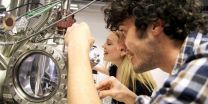(Press-News.org) This news release is available in French.
Montreal, July 9, 2015 -- Death rates due to health problems like obesity, type 2 diabetes, hypertension, and heart disease are on the rise. According to the World Health Organization, that's due to our increasingly sedentary lifestyles.
Clearly, it's important to lead more active lives. Something as simple as taking the stairs can make a big difference. But can pedestrians be convinced to make healthy choices when an escalator seems so much faster and more convenient than a staircase?
Yes, say researchers from Concordia and Peking universities. You just have to make sure that the stairs are far, far away from the escalator -- 100 per cent farther away, in fact.
Going up...
The study, recently published in Environment and Behaviour, examines the theory that separating stairways from escalators between pairs of origin and destination floors in a shopping center would increase the rate at which the stairways were used.
To test the hypothesis, the researchers monitored 13 stairways and 12 pairs of escalators in seven connected shopping centres in downtown Montreal. Counts of moving pedestrians on stairs or escalator were conducted in five-minute blocks by a single observer, who watched the traffic flow between 10:30 a.m. to 12:00 noon, and from 12:30 p.m. to 2:30 p.m., to ensure variability. A total of 33,793 pedestrians were counted ascending or descending over 35 days.
When the researchers examined the data, they found that increasing the distance between a stairway and an escalator by 100 per cent accounted for 71 per cent of variance when shoppers were going up, and 21 per cent of variance when they were going down. Overall, that's a 95 per cent increase in stair use.
Step by step
"Environmental factors have been explicitly identified as having an impact on stair climbing, including the visibility of the stairway and its width. This study shows that staircase location is just as important, and should be factored in when planning new buildings," says senior author John Zacharias, who conducted the study while a faculty member in the Department of Geography, Planning and Environment at Concordia. He is now a professor at the University of Peking.
For study co-author and Concordia psychology alumnus Richard Ling, the health outcomes of this study are most important. "The initial focus of the research was to determine what correlation might exist between the separation or proximity of stairs and escalators to the decision to use one or the other. The results support an interesting point of logic for those who design space for health optimization," he says.
INFORMATION:
Related links:
Cited study http://eab.sagepub.com/content/early/2014/01/28/0013916513520418
Concordia Alumni & Friends http://www.concordia.ca/alumni-friends.html
Peking University http://english.pku.edu.cn/
Media contact:
Cléa Desjardins
Senior advisor, media relations
University Communications Services
Concordia University
Phone: 514-848-2424, ext. 5068
Email: clea.desjardins@concordia.ca
Web: http://www.concordia.ca/now/media-relations
Twitter: @CleaDesjardins
Around 85% of the matter in the Universe is dark [1], and of a type not understood by physicists. Although it doesn't shine or absorb light, astronomers can detect this dark matter through its effect on stars and galaxies, specifically from its gravitational pull. A major project using ESO's powerful survey telescopes is now showing more clearly than ever before the relationships between this mysterious dark matter and the shining galaxies that we can observe directly [2].
The project, known as the Kilo-Degree Survey (KiDS - http://kids.strw.leidenuniv.nl/), uses imaging ...
Childhood high blood pressure (HBP) is a serious public health challenge worldwide due to associated increases in risk of end organ damages and correlation with HBP in adulthood. The prevalence of elevated blood pressure (BP) has been reported to increase significantly among United States children and adolescents from 1988-1994 to 1999-2008, but little is known about recent trends in BP values and elevated BP. The authors of a new study, "Trends in elevated blood pressure among US children and adolescents: 1999-2012," published today by the American Journal of Hypertension, ...
ANN ARBOR--University of Michigan researchers and their colleagues predict that the 2015 western Lake Erie harmful algal bloom season will be among the most severe in recent years and could become the second-most severe behind the record-setting 2011 bloom.
The 2015 seasonal forecast uses models that translate spring nutrient loading into predicted algal blooms in the Western Basin of Lake Erie. After a relatively dry April and May, the heavy rains in June produced record discharge and nutrient loadings from the Maumee River, which runs through Toledo and northeastern ...
This news release is available in German.
Graphene, the only one atom thick carbon network, achieved overnight fame with the 2010 Nobel Prize. But now comes competition: Such layers can also be formed by black phosphorous. Chemists at the Technische Universität München (TUM) have now developed a semiconducting material in which individual phosphorus atoms are replaced by arsenic. In a collaborative international effort, American colleagues have built the first field-effect transistors from the new material.
For many decades silicon has formed the ...
Chicago - Although opioids are frequently prescribed to treat chronic lower back pain, new research suggests these powerful medications may be less effective in some patients. A study published in the Online First edition of Anesthesiology, the official medical journal of the American Society of Anesthesiologists® (ASA®), found patients who were prescribed opioids to treat chronic lower back pain experienced significantly less pain relief and were more likely to abuse their medication when they had psychiatric disorders such as depression or anxiety.
"High levels ...
Neuroscientists at Duke University have introduced a new paradigm for brain-machine interfaces that investigates the physiological properties and adaptability of brain circuits, and how the brains of two or more animals can work together to complete simple tasks.
These brain networks, or Brainets, are described in two articles to be published in the July 9, 2015, issue of Scientific Reports. In separate experiments reported in the journal, the brains of monkeys and the brains of rats are linked, allowing the animals to exchange sensory and motor information in real time ...
The human eye is an amazing instrument and can accurately distinguish between the tiniest, most subtle differences in color. Where human vision excels in one area, it seems to fall short in others, such as perceiving minuscule details because of the natural limitations of human optics.
In a paper published today in The Optical Society's new, high-impact journal Optica, a research team from the University of Stuttgart, Germany and the University of Eastern Finland, Joensuu, Finland, has harnessed the human eye's color-sensing strengths to give the eye the ability to ...
UBC research shows world's monitored seabird populations have dropped 70 per cent since the 1950s, a stark indication that marine ecosystems are not doing well.
Michelle Paleczny, a UBC master's student and researcher with the Sea Around Us project, and co-authors compiled information on more than 500 seabird populations from around the world, representing 19 per cent of the global seabird population. They found overall populations had declined by 69.6 per cent, equivalent to a loss of about 230 million birds in 60 years.
"Seabirds are particularly good indicators of ...
Chemotherapy treatment usually involves the patient receiving medicine through an intravenous catheter. These catheters, as well as the the equipment attached to them, are treated with a silver coating which is antibacterial, preventing bacterial growth and unwanted infections during a treatment.
Researchers at the Norwegian University of Science and Technology's (NTNU) Department of Physics are now studying what happens when different drugs come in contact with this silver coating.
Silver breaks down chemotherapy drugs
"We wanted to find potential problem sources ...
This news release is available in German.
Although global concentration of greenhouse gases in the atmosphere has continuously increased over the past decade, the mean global surface temperature has not followed the same path. A team of international reseachers, KIT scientists among them, have now found an explanation for this slowing down in global warming: the incoming solar radiation in the years 2008-2011 was twice as much reflected by volcanic aerosol particles in the lowest part of the stratosphere than previously thought. The team presents their study ...





